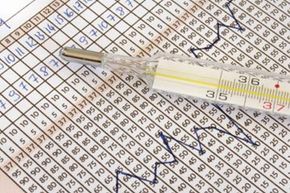
The biology of making a baby sounds simple. Combine sperm and egg, and in nine months, you have an infant, right? Unfortunately, some of us need a little more planning. Body temperatures, calendars, rhythms … getting pregnant can certainly seem more like an art than a science. Just how well can you determine the most optimal time to conceive?
Conception can happen after a woman ovulates. Ovulation occurs every month about midway through a woman’s menstrual cycle. During ovulation, a woman’s ovary releases a mature egg, which then travels through the fallopian tube, where a sperm can fertilize it. If an egg isn’t fertilized, it passes out of the body, and the cycle begins again.
After ovulation, you have a 12- to 24-hour window for the sperm to fertilize the egg, and when you’re trying to conceive, that’s not much time to get it right [source: WebMD]. On top of that, ovulation doesn’t always occur at the same time during each monthly cycle. Factors such as significant weight changes, excessive exercise, stress and illness can all prevent you from ovulating regularly.
However, pinpointing the moment you ovulate doesn’t have to be a roll of the dice. Your body does send signals to help you figure it out. Pay attention to these signs, and you may know when you’re ovulating.
- Cervical mucus: Your cervical mucus changes throughout your menstrual cycle. Just before you ovulate, the amount of mucus increases and becomes sticky and slippery.
- Basal body temperature: Basal body temperature is your resting temperature. When you’re ovulating, your temperature may rise slightly.
- Cramping: Some women experience slight abdominal cramping when they ovulate.
Now that you know what to look for when you ovulate, let’s see if you can predict your actual day of ovulation.
Predicting Ovulation
Predicting when you’re going to ovulate may take many months of data gathering, and even then, you might not get an exact day of ovulation. Still, knowing the days you’ll be most fertile can help you conceive. Several tracking methods can help you notice the patterns in your menstrual cycle:
Basal body temperature — Use a basal body thermometer to track your temperature to hundredths of degrees. You’ll have to take your temperature right when you wake up because if you get out of bed, you could affect the reading. Chart your results for several months. If you see a rise in temperature, that denotes when you’re ovulating. This method doesn’t pinpoint the exact date of ovulation, but many women ovulate within three days of this temperature shift.
Calendar — Take note when your period starts and mark it on a calendar. This is day one of your menstrual cycle. Also, keep track of how many days it lasts. Ovulation tends to occur two weeks before you begin your period, so if you track several months’ worth, you’ll be able to learn how long your average cycle is, which will help you estimate ovulation. For a 28-day cycle, this will be around day 14. If you have a longer or shorter cycle, you’ll likely ovulate on a different day, possibly even while you’re menstruating.
Cervical mucus — The mucus your cervix produces changes throughout your menstrual cycle. During ovulation, it becomes thin, slippery, more translucent and stretchy.
Ovulation tests — Over-the-counter ovulation predictor kits help pinpoint your most fertile days. They test either urine or saliva for the presence of luteinizing hormone (LH). LH increases dramatically for about two days before ovulation. When you see a surge of LH, an egg will be released within 35 to 44 hours [source: Morrison]. These tests can be pricy, and like the other methods, they only tell you when you’re likely to ovulate. However, you don’t have to track data for months.
Although it’s tough to pinpoint an exact date of ovulation, you can learn to read your body’s signs to discover when you’re most likely to be fertile. For even more information about ovulation and fertility, check out the links on the next page.
What is cervical mucus?
Your cervix naturally creates secretions that change throughout your menstrual cycle. After your period, you may see none of this mucus. As an egg ripens, thick, cloudy mucus starts to develop at your vaginal opening. This prevents sperm from getting into the uterus. However, during ovulation these secretions become clear, thin and slippery, creating the ideal environment for sperm to travel through the cervix, uterus and fallopian tubes to reach the egg — this particular type of cervical mucus can even provide healthy sperm with protection from the vagina’s acidity. After ovulation, the mucus becomes cloudy again, and just before your period, the mucus will dry up.
Lots More Information
Related Articles
- Signs of Ovulation
- 5 Reasons to Monitor Ovulation
- Pros and Cons of Ovulation Predictor Kits
- How to Use Ovulation Tests
Sources
- Burgess, Kelly. "All About Ovulation: the inside story to help you conceive." Pregnancy Today. (April 18. 2011)http://www.pregnancytoday.com/articles/preconception/all-about-ovulation-4950/1/
- Mayo Clinic. "Cervical mucus method for natural family planning." Nov. 20, 2009. (April 18, 2011)http://www.mayoclinic.com/health/cervical-mucus-method/MY01004
- Mayo Clinic. "How to get pregnant." April 16, 2011. (April 18, 2011)http://www.mayoclinic.com/health/how-to-get-pregnant/PR00103
- Morrison, Gwen. "The Power of Fertility Prediction: how ovulation tests can help you conceive." (April 18, 2011)http://www.pregnancytoday.com/articles/charting-and-tracking-fertility/the-power-of-fertility-prediction-1463/
- Planned Parenthood. "Cervical Mucus Method." (April 18, 2011)http://www.plannedparenthood.org/health-topics/birth-control/fam-cervical-mucus-method-22140.htm
- WebMD. "Charting Your Fertility Cycle." Feb. 25, 2010. (April 18, 2011)http://www.webmd.com/infertility-and-reproduction/fertility-tests-for-women?page=1
- WebMD. "Pregnancy and Conception." Dec. 20, 2009. (April 18, 2011)http://www.webmd.com/baby/guide/understanding-conception